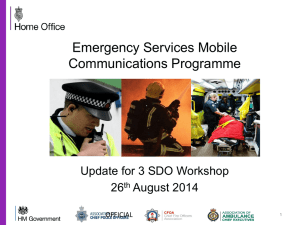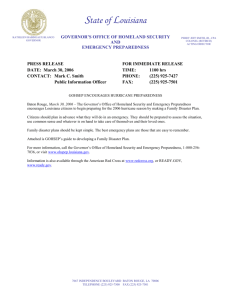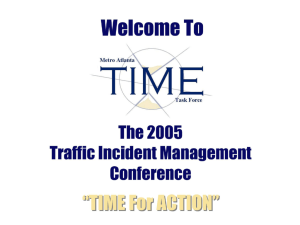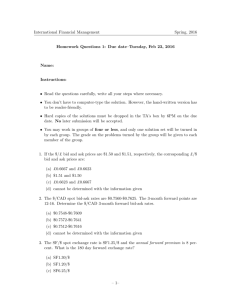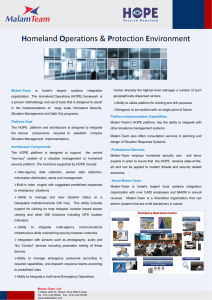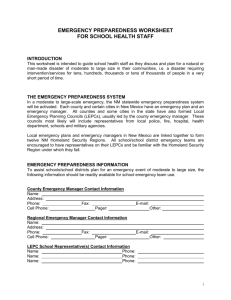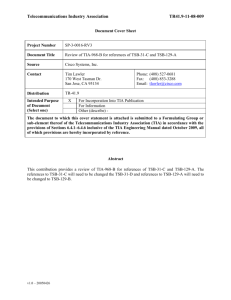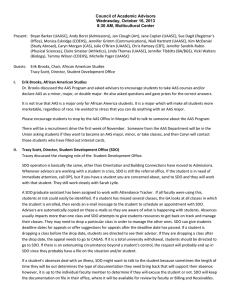ANSI Presentation Template - Emergency Services Workshop
advertisement
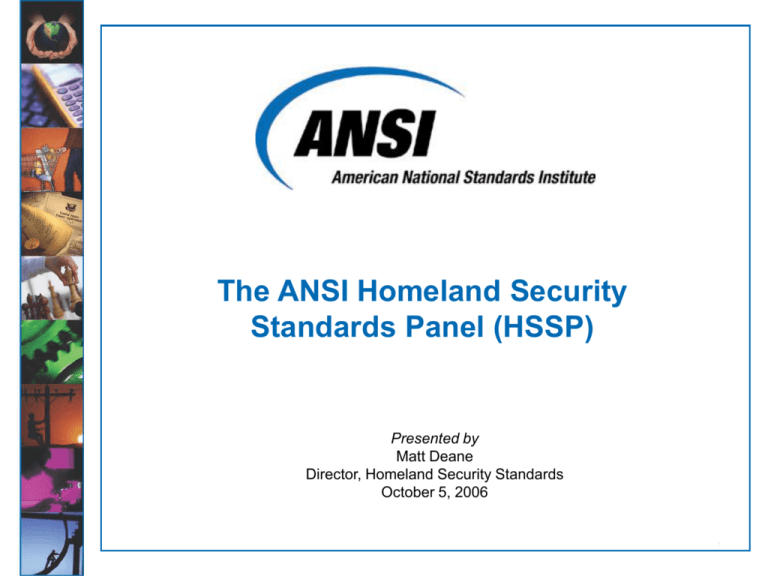
The ANSI Homeland Security Standards Panel (HSSP) Presented by Matt Deane Director, Homeland Security Standards October 5, 2006 1 American National Standards Institute To enhance the global competitiveness of U.S. business and the American quality of life by promoting and facilitating voluntary consensus standards and conformity assessment systems and ensuring their integrity. A Private- and Public-Sector Partnership Since 1918 ANSI is not a government agency or a standards developer. SDO Emergency Service Workshop October 5-6, 2006 Slide 2 ANSI Roles and Responsibilities Accredit U.S. Standards Developers, U.S. Technical Advisory Groups and conformity assessment systems Ensure integrity of the U.S. voluntary consensus standards system Provide access to regional and international standards organizations Respond to urgent national priorities Offer a neutral policy forum for standards and CA coordination issues - Section 1.02 (1) of ANSI By-Laws SDO Emergency Service Workshop October 5-6, 2006 Slide 3 Rationale for the ANSI-HSSP The National Strategy for Homeland Security (2002) identified the need for standards to support homeland security and EP A January 2, 2003 Congressional Research Service report underscored this important role needed: “Neither the federal government, nor the nongovernmental sector presently has a comprehensive, consolidated program for developing new preparedness standards.” Following conversations with the U.S. Office of Homeland Security and key security stakeholders, ANSI launched the ANSI-HSSP on February 5, 2003 (continued) SDO Emergency Service Workshop October 5-6, 2006 Slide 4 Mission Identify and facilitate the development and enhancement of homeland security standards Serve as private/public sector partnership for standards issues that cut cross-sector Support the work of the Standard Portfolio of the DHS Science and Technology (S&T) Directorate Provide a forum for information sharing on homeland security standards issue, as well as the overall standards development and conformity assessment processes Facilitate dialogue and networking on key issues for homeland security stakeholders SDO Emergency Service Workshop October 5-6, 2006 Slide 5 Structure Co-Chairs (private and public sector) Dan Bart, Telecommunications Industry Association (TIA) Mary Saunders, National Institute of Standards and Technology (NIST) Steering Committee Comprised of Government Agencies, ANSI SDOs, non-ANSI SDOs, Companies, and five at-large seats (continued) SDO Emergency Service Workshop October 5-6, 2006 Slide 6 Structure (continued) Full Panel Approximately 100 organizational participants; open to all affected interests; brought together via Plenary meetings Workshops Address specific homeland security issues; objectives are typically to identify existing standards and conformity assessment programs, gap areas, and make recommendations for addressing these gaps SDO Emergency Service Workshop October 5-6, 2006 Slide 7 Selected Accomplishments Private Sector Emergency Preparedness and Business Continuity Biometrics Recommendation from workshop (NFPA 1600) was included in the recommendations section of the 9/11 Commission’s final report Produced a report in 2004 of existing standards and projects under development, as well as five key issues and recommendations related to biometric standardization and conformity assessment Biological and Chemical Threat Agents 400-page final report, containing relevant standards and projects under development, published in December 2004 (continued) SDO Emergency Service Workshop October 5-6, 2006 Slide 8 Selected Accomplishments Training Programs for First Response to WMD Events Report examines how standards play a role in tackling the practical challenges and solutions related to keeping critical operations, equipment or facilities powered when the public electric grid is not available Perimeter Security Workshop report focuses on standards that support training programs and can be used to help measure their effectiveness, as well as areas needing further exploration Enterprise Power Security (continued) Addressing standards for security technologies and systems needed to complement and enhance guards, gates, and personnel verification Created a Homeland Security Standards Database to capture key standards and serve as a resource for the HS community www.hssd.us SDO Emergency Service Workshop October 5-6, 2006 Slide 9 Emergency Preparedness July 12th kick-off meeting of workshop on Lessons Learned from Hurricane Katrina and Role for Standards and Conformity Assessment Programs Final report from the workshop will demonstrate the linkages between the elements of NFPA 1600 and the major recommendations for catastrophic event preparedness that have emerged as lessons learned Fifth ANSI-HSSP Plenary themed on Emergency Preparedness was held September 25-26, 2006 at NYU Covered topics such as accreditation and certification in private sector preparedness; public sector preparedness initiatives; credentialing Three breakout sessions Planning for a Global Pandemic Mass/Public Transportation Security All Hazards Planning, Response and Recovery SDO Emergency Service Workshop October 5-6, 2006 Slide 10 ANSI-HSSP Work in Emergency Communications ANSI-HSSP convened two workshop meetings on the subject of Emergency Communications, addressing subjects such as: EC Lessons Learned from Hurricanes Rita, Katrina, and Wilma Various EC initiatives (e.g., FCC work, GSC-10 Resolution, NRIC VII Review of PSAPs, WARN Act, NENA NG E9-1-1) New technology initiatives for EC International issues for EC Dan Bart (TIA) served as workshop leader Participants from both public and private sectors, representing a number of different industry areas Breakout sessions addressed three of the four “legs” of emergency communications SDO Emergency Service Workshop October 5-6, 2006 Slide 11 Types of Emergency Communications Indiv/Org-to-Indiv/Org: An individual communicating an emergency to another individual or private organization via available options (e.g., ONSTARlike message, amateur radio, mobile and land-line communications, broadcast and mass media, Internet, email lists, faxes, information services, and word of mouth). Indiv/Org-to-Government: An individual communicating an emergency message to appropriate authorities via available options (e.g., E9-1-1/1-1-2 call to Public Safety Answering Point (PSAP), amateur radio, and mobile communications (with or without location services)). Government-to-Government: Governmental authorities communicating to each other, other agencies and appropriate National Security / Emergency Preparedness (NS/EP)-designated private industry concerns and coordinators (i.e., using all forms of communications services, private radio, Commercial Mobile Radio Services, e-mail/messaging alerts, etc.). Government-to-Indiv/Org: Government or authorized officials communicating alerts or details of an emergency to individuals and organizations via available options (e.g., Governmental mass media alerts, citizen accessible radio services and common channels, highway alerts, voluntary private sector alert services [localized and national], e-mail/voice-mail and word of mouth). SDO Emergency Service Workshop October 5-6, 2006 Slide 12 Indiv/Org-to-Government Issues Discussed Focus on 9-1-1 from citizens to Public Safety Answering Point (PSAP), where 9-1-1 exists 10-digit lines (Alarm companies from out of area) Third-party call centers (e.g., On-Star, ATX) Need to consider individuals with disabilities and non-English speaking individuals Although redundancy is provided, what should citizens do if they cannot reach 9-1-1? Calls also to Homeland Security Operations Center (HSOC) PSAP training, protocols, and credentialing need to be considered by those entities focusing on government-to-government emergency communications SDO Emergency Service Workshop October 5-6, 2006 Slide 13 Categorizing/Tracking Standards and Identifying Gaps in Emergency Communications ACCESS POINT POTS Cell Phones PSAP Personnel* (e.g., training, procedures, certification) - ATIS-0500004 - ATIS-0500005 3rd Party Call Center* (e.g. OnStar, ATX, TeleAid, TRS) Personnel Training & Certification - ATIS-0500005 Communication Devices Technical Infrastructure - TIA TR-30 - TIA-689-A-2003 (TR-41.1) - TR-41.3 - T1.XXX-2000 - TIA TR-45 - TIA/EIA-2000 - TIA/EIA-136 - ATIS-PP-0500002-200X - J-STD-025 -ATIS-0500001 - ATIS ESIF Issue 30 - ATIS ESIF Issue 33 - ATIS-PP-0500002-200X -J-STD-025, J-STD-034, J-STD-036 - T1.678 VoIP -TIA TSB-146 (TR-41.4) -TIA-1057 (TR-41.4) - TIA TR-45 - TIA-2000-C SDO Emergency Service Workshop October 5-6, 2006 - ATIS-PP-0500002-200X - TIA TR-30 - TIA-1001 (TR-30.1) - TIA-1066 - TIA-878 - TIA-2000-C - T1.724 Slide 14 Current Status of EC Workshop Participants agreed that no further in-person meetings needed at this time A final workshop white paper will outline the key issues, emergency communications standards identified, gaps/needs areas, and resources for further information/possible partnerships White paper due by end of the year If further issues arise or additional work needed, the Workshop will be reconvened SDO Emergency Service Workshop October 5-6, 2006 Slide 15 Further Information Accomplishments of the Panel at its Three-Year Anniversary is posted to the ANSI-HSSP website: www.ansi.org/hssp ANSI-HSSP welcomes subject matter experts to attend its Workshops and Plenary meetings Information on joining the ANSI-HSSP and benefits of participation can be obtained from the Secretary ANSI-HSSP Secretary Matt Deane Director, Homeland Security Standards mdeane@ansi.org 212-642-4992 SDO Emergency Service Workshop October 5-6, 2006 Slide 16
